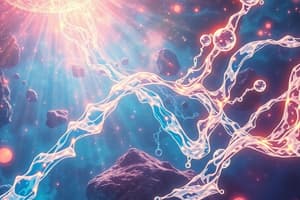Podcast
Questions and Answers
Care dintre următoarele substanțe este un electrolit puternic?
Care dintre următoarele substanțe este un electrolit puternic?
- Hidroxid de sodiu (NaOH) (correct)
- Acid acetic
- Etanol
- Glucoză
Care este definiția corectă a pH-ului?
Care este definiția corectă a pH-ului?
- Toate cele de mai sus
- Măsura concentrației ionilor de hidrogen (H+) dintr-o soluție (correct)
- Măsura concentrației ionilor de hidroxid (OH-) dintr-o soluție
- Măsura acidității sau alcalinității unei soluții
Ce tip de electrolit este acidul acetic?
Ce tip de electrolit este acidul acetic?
- Nelectrolit
- Electrolit puternic
- Electrolit semi-puternic
- Electrolit slab (correct)
Care dintre următoarele reacții descrie disocierea acidului clorhidric (HCl) în apă?
Care dintre următoarele reacții descrie disocierea acidului clorhidric (HCl) în apă?
Care dintre următoarele este un exemplu de bază slabă?
Care dintre următoarele este un exemplu de bază slabă?
Care dintre următoarele este adevărat despre disocierea acizilor și bazelor?
Care dintre următoarele este adevărat despre disocierea acizilor și bazelor?
Care este valoarea pH-ului pentru o soluție neutră?
Care este valoarea pH-ului pentru o soluție neutră?
Care dintre următoarele afirmații despre modelul Brønsted-Lowry este corectă?
Care dintre următoarele afirmații despre modelul Brønsted-Lowry este corectă?
Study Notes
Electrolyte Dissociation
- Electrolyte dissociation is the process by which ionic compounds (electrolytes) separate into their constituent ions when dissolved in a polar solvent, like water.
- This separation occurs due to the interaction between the polar solvent molecules and the ions of the electrolyte.
- Strong electrolytes dissociate completely in solution, producing a high concentration of ions.
- Weak electrolytes dissociate only partially in solution, giving a low concentration of ions.
- The degree of dissociation depends on factors like the nature of the electrolyte and the solvent.
Types of Electrolytes
- Strong electrolytes: Completely dissociate into ions in solution. Examples include strong acids (HCl, HNO₃, H₂SO₄), strong bases (NaOH, KOH), and most soluble salts.
- Weak electrolytes: Only partially dissociate into ions in solution. Examples include weak acids (acetic acid, carbonic acid) and weak bases (ammonia).
- Non-electrolytes: Do not dissociate into ions in solution. Examples include sugar (sucrose) and ethanol.
pH
- pH is a measure of the hydrogen ion (H⁺) concentration in a solution.
- It is defined as the negative logarithm (base 10) of the hydrogen ion concentration: pH = -log₁₀[H⁺].
- A lower pH indicates a higher concentration of H⁺ ions, meaning the solution is more acidic.
- A higher pH indicates a lower concentration of H⁺ ions, meaning the solution is more basic (alkaline).
- A pH of 7 is considered neutral, representing the concentration of H⁺ ions in pure water.
Dissociation of Acids and Bases
- Acids: Substances that release hydrogen ions (H⁺) when dissolved in water.
- Bases: Substances that release hydroxide ions (OH⁻) when dissolved in water, or accept H⁺ ions.
- Strong acids completely ionize, increasing the concentration of H⁺.
- Weak acids only partially ionize, resulting in a lower concentration of H⁺.
- Strong bases completely dissociate, increasing the concentration of OH⁻.
- Weak bases only partially dissociate, resulting in a lower concentration of OH⁻.
- Arrhenius Definition: Acids produce H⁺ ions in water, bases produce OH⁻ ions.
- Brønsted-Lowry Definition: Acids are proton donors, bases are proton acceptors. This definition is broader, encompassing more species as acids or bases.
- Important aspects of the dissociation of acids and bases include the equilibrium constant associated with the reaction (Ka for acids, Kb for bases), and the relative strengths (strong vs. weak) of the acids and bases. The conjugate acid-base pairs arising from the dissociation are also important.
Studying That Suits You
Use AI to generate personalized quizzes and flashcards to suit your learning preferences.




